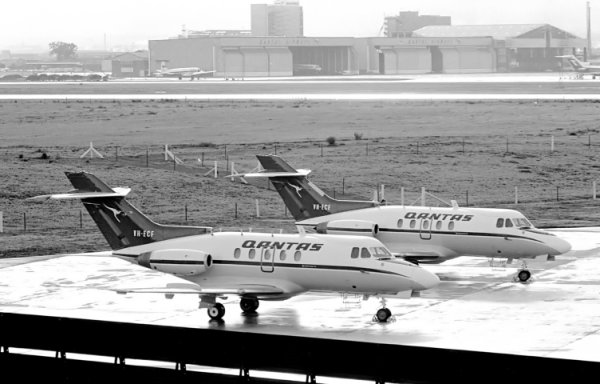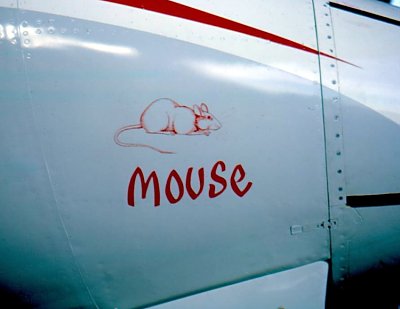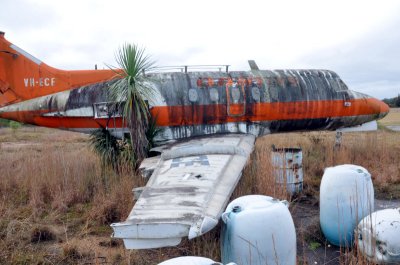LITTLE SISTERS
|
During
the 707 era, Qantas operated two Hawker Siddeley HS.125 Series 3B
business jets for crew training purposes. At this time, it was necessary
for Second Officers to undertake recency training in an aircraft,
as flight simulators, although widely used in Qantas, had not reached
the required level of fidelity for the necessary training to be
done in the simulator. The use of a 707 for this training was not
viable, both in terms of cost and aircraft availability. Although
Qantas retained two DC-3s for crew training (VH-EDC and VH-EDD)
there was a requirement for a more modern type. Another factor which
led to the acquisition of the HS.125s was the loss of PNG domestic
operations to TAA in August 1960 which deprived Qantas of this useful
training ground. Thus, on 8 September 1964, Qantas announced an
order for two HS.125s. The choice of the HS.125, it was later claimed
by then Vice-Chairman, R.R. Law-Smith, was an offset for Qantas
being given traffic rights between London and Bermuda.
As the need
for the HS.125s diminished with advances in flight simulators, VH-ECF
was sold in late 1972 to McAlpine Aviation in the United Kingdom,
leaving VH-ECE to soldier on alone. During 1973, VH-ECE was examined
by Adastra Aerial Surveys with a view to fitting an RC9 survey camera
into an HS.125 for high altitude photography. A subsequent flight
evaluation of an HS.125 belonging to another operator was unsatisfactory
and the project was never proceeded with (read more here).
In October 1981, VH-ECE was sold to Qantas Flight Engineer, Graham Onus and stored at The Oaks where the aeroplane is now neglected and derelict. The former VH-ECF was sadly destroyed in a fatal crash near Columbia, Missouri in January 1990. |
|
REGN.
|
MSN
|
DELIVERED
|
DISPOSED
|
REMARKS
|
|
|
VH-ECE
|
25062
|
15JUN66
|
08OCT81
|
MAR67
|
Leased
to the Dept. of Civil Aviation from March to July 1967 while VH-CAO
was being repaired. Currently stored in derelict condition at The Oaks, NSW. |
|
VH-ECF
|
25069
|
08JUL66
|
27NOV72
|
06JAN68
|
Landed at Oakey to transport the Mayoress of Toowoomba to Sydney for the naming ceremony of the new Boeing 707-338C VH-EAA City of Toowoomba. |
|
01JAN70
|
Departed London Gatwick in the England to Australia Air Race. | ||||
|
02JAN70
|
Arrived at Adelaide in first place in the special jet category. | ||||
|
24DEC71
|
Chartered by Business Jets. (JAHSA Vol 12 No 6) | ||||
|
05JUN72
|
Business
Jets commenced RPT operations using their Falcon VH-BIZ. To serve
charter commitments, HS.125 VH-ECF was leased with a BIZJETS sticker
in white letters outlined in red. (JAHSA Vol 13 No 3) |
||||
|
20NOV72
|
Departed Sydney in an all-white scheme for the U.K. | ||||
|
27NOV72
|
Sold to McAlpine Aviation Ltd, as |
||||
|
24FEB76
|
Sold
to Dennis Vanguard Intl (Switchgear) Ltd as |
||||
|
25JUL89
|
Registered G-OBOB to Slender You (UK) Ltd. | ||||
|
30JAN90
|
Crashed and written off near Columbia Regional Airport, Missouri, USA. | ||||
|
VH-ECE
|
||||
 |
 |
|||
|
VH-ECF
|
||||
|
Message
to the Owner of VH-ECE
|
Pick a Museum - any Museum
If you are not going to preserve this aeroplane yourself, please donate it to a museum - any museum. The choice is yours whether history remembers you as the person who saved the aeroplane for future generations or the person who presided over its destruction. |
OTHER AUSTRALIAN HS.125 OPERATORS
|
Qantas was not the only Australian operator of the HS.125, nor was it the first. On 20 January 1965, HS.125-1B VH-CAO (msn 25015) arrived at Essendon on delivery to the Department of Civil Aviation. The aircraft was used principally for the purpose of providing jet experience for the Department's Examiners of Airmen although it was also used for other DCA needs and occasional VIP transport. It was not, as is popularly believed, equipped for navaid calibration. VH-CAO featured in a widely publicised incident when it was inadvertently landed wheels-up at Avalon, Vic on 24 January 1967. While the aircraft was being repaired by Hawker de Havilland at Bankstown, NSW, the DCA leased VH-ECE from Qantas until July 1967 when VH-CAO returned to service. During its lease to the DCA, VH-ECE operated in full Qantas livery and no additional DCA titles were carried. During its repairs, VH-CAO was fitted with new Viper 522 engines in place of the earlier Viper 521s and thus emerged as an HS.125-3B. Such was the damage caused by the belly landing, that VH-CAO had to be fitted with a new wing. When the aircraft was recovered from the Avalon runway, poor placement of lifting straps caused some minor wrinkling of the fuselage aft of the cockpit. It had been hoped that these wrinkles would disappear after several pressurisation cycles but they never did. VH-CAO served the Department until 1 August 1978 when ownership was transferred to Arnjul Pty. Ltd. of Auburn, NSW. Coincidentally, at the time of writing, VH-ECE and VH-CAO both cling to life, seemingly abandoned in outdoor storage at The Oaks, NSW and both owned by the same person. It is to be hoped that their owner will take steps to ensure the preservation of these historic aeroplanes.
THE DEPARTMENT
OF CIVIL AVIATION HS.125
|
|
24JAN67
|
VH-CAO landed wheels-up at Avalon, Vic. |
|
22FEB67
|
VH-CAO was noted on a truck at Essendon |
|
25FEB67
|
VH-CAO arrived at Bankstown, NSW on two trucks. |
|
06MAR67
|
VH-ECE arrived at Essendon, Vic on lease to DCA. |
|
25JUL67
|
VH-CAO
returned to Essendon after repairs at Bankstown. VH-ECE was returned to Qantas around this time. |
|
27JUL67
|
VH-CAO became the first fixed wing aircraft to land at Melbourne's new Tullamarine Airport. On board were the Minister for Civil Aviation and the Director General of Civil Aviation. |
Other Australian HS.125s of this period were:
VH-BBJ
HS.125-3B/RA (msn 25169) delivered to Bell Brothers Air Charter
Pty. Ltd., Guildford, WA in January 1970 and sold overseas in June
1972.
VH-TOM
HS.125-400B (msn 25242) delivered to Tom the Cheap (WA) Pty. Ltd.,
Perth, WA in January 1971 and sold overseas in December 1973.
The Australian Register also included several later versions of
the HS.125 under various designations.
|
SOURCES
|
| High Corridors - Qantas 1954-1970 by John Gunn (UQP 1988) |
| Flypast - A Record of Aviation in Australia by Neville Parnell and Trevor Boughton (AGPS 1988) |
| The Historic Civil Aircraft Register of Australia by Tony Arbon and David Sparrow (AustAirData) |
| Aviation Safety Network http://aviation-safety.net |
|
Issue
|
Date
|
Remarks |
|
13
|
07MAR22
|
Corrected the location of the crash of G-OBOB, formerly VH-ECF. |
|
12
|
13AUG21
|
Added an image of VH-ECE thanks to Alan Flett. |
|
11
|
10JUN21
|
Added an image of VH-ECF thanks to Eric Allen. |
|
10
|
30MAY21
|
Added a reference to VH-ECF being chartered by BizJets. |
|
9
|
05FEB21
|
Further expanded the reference to one of the Qantas HS.125s being named Mouse. Thanks to Robert Phillips. |
|
8
|
03FEB21
|
Expanded the reference to one of the Qantas HS.125s being named Mouse. Thanks to Roger Chin. |
|
7
|
01DEC20
|
Added
two images thanks to Eric Allen. Image 1
|
|
6
|
10NOV20
|
The image gallery has been greatly expanded. |
|
5
|
17AUG12
|
Added the date that VH-ECF departed SYD for the UK. Thanks to Gordon Reid and Essendon Newsletter 62/65 OCT72. |
|
4
|
21JAN08
|
Added the date that DCA disposed of VH-CAO (01AUG78). Thanks to Tony Arbon. |
|
3
|
20JAN08
|
Added
a reference to other Australian operators of the HS.125 and the lease
of VH-ECE to the Department of Civil Aviation while VH-CAO was under
repair. Thanks to Geoff Goodall, Gordon Reid and Ted Dewey. Further references to "Mouse" were added thanks to Roger Chin. Also added recent images of VH-ECE and VH-CAO at The Oaks thanks to Rod Hobson. |
|
2
|
03JAN08
|
Added a reference to "Mouse". |

































